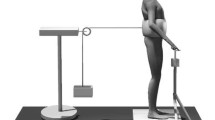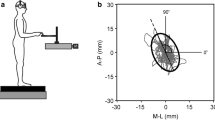Abstract
It is well known that a light and voluntary touch with a fingertip on a fixed surface improves postural stability during quiet standing. To determine whether the effect of the light touch is due to the tactile sensory input, as opposed to mechanical support, we investigated the light touch effect on postural stability during quiet standing with and without somatosensory input from the fingertip. Seven young subjects maintained quiet standing on a force platform with (LT) and without (NT) lightly touching a fixed surface, and with (TIS) and without (CON) the application of tourniquet ischemia, which removed the tactile sensation from the fingertip. The mean velocity of centre of pressure (CoP) was calculated to assess the postural sway in each condition. The mean velocity of CoP was significantly smaller in the LT condition compared to the NT condition only under the CON condition, whereas the light touch effect was not significant under the TIS condition. We found that the reduction of the horizontal ground reaction force due to the light touch was about 20%, which was approximately equivalent to the reduction of mean velocity of CoP in the LT condition compared to the NT condition. Since the fingertip contact force was relatively large compared to the horizontal ground reaction force, one could say that the light touch effect might be due to the mechanical support provided by the contact itself. However, we demonstrated experimentally that light touch effects were diminished due to loss of finger tactile feedback induced by the tourniquet ischemia, but not due to the mechanical support provided by the light touch. One possible reason is the lack of feedback information in controlling posture, and the other is the altered control of the arm induced by the loss of tactile feedback.


Similar content being viewed by others
Abbreviations
- CoP:
-
Centre of pressure
- CON:
-
Control
- GRF:
-
Ground reaction force
- NT:
-
No touch
- LT:
-
Light touch
- SD:
-
Standard deviation
- TIS:
-
Tourniquet ischemia
References
Bostock H, Burke D, Hales JP (1994) Differences in behaviour of sensory and motor axons following release of ischaemia. Brain 117:225–234
Bove M, Bonzano L, Trompetto C, Abbruzzese G, Schieppati M (2006) The postural disorientation induced by neck muscle vibration subsides on lightly touching a stationary surface or aiming at it. Neuroscience 143:1095–1103
Clapp S, Wing AM (1999) Light touch contribution to balance in normal bipedal stance. Exp Brain Res 125:521–524
Dickstein R, Shupert CL, Horak FB (2001) Fingertip touch improves postural stability in patients with peripheral neuropathy. Gait Posture 14:238–247
Goldie PA, Bach TM, Evans OM (1989) Force platform measures for evaluating postural control: reliability and validity. Arch Phys Med Rehabil 70:510–517
Holden M, Ventura J, Lackner JR (1994) Stabilization of posture by precision contact of the index finger. J Vestib Res 4:285–301
Jeka JJ (1997) Light touch contact as a balance aid. Phys Ther 77:476–487
Jeka JJ, Easton RD, Bentzen BL, Lackner JR (1996) Haptic cues for orientation and postural control in sighted and blind individuals. Percept Psychophys 58:409–423
Jeka JJ, Lackner JR (1994) Fingertip contact influences human postural control. Exp Brain Res 100:495–502
Jeka JJ, Lackner JR (1995) The role of haptic cues from rough and slippery surfaces in human postural control. Exp Brain Res 103:267–276
Jeka J, Oie KS, Kiemel T (2000) Multisensory information for human postural control: integrating touch and vision. Exp Brain Res 134:107–125
Jeka JJ, Ribeiro P, Oie K, Lackner JR (1998) The structure of somatosensory information for human postural control. Motor Control 2:13–33
Kouzaki M, Masani K, Akima H, Shirasawa H, Fukuoka H, Kanehisa H, Fukunaga T (2007) Effects of 20-day bed rest with and without strength training on postural sway during quiet standing. Acta Physiol 189:279–292
Krishnamoorthy V, Slijper H, Latash ML (2002) Effects of different types of light touch on postural sway. Exp Brain Res 147:71–79
Lackner JR, DiZio P, Jeka J, Horak F, Krebs D, Rabin E (1999) Precision contact of the fingertip reduces postural sway of individuals with bilateral vestibular loss. Exp Brain Res 126:459–466
Lackner JR, Rabin E, DiZio P (2000) Fingertip contact suppresses the destabilizing influence of leg muscle vibration. J Neurophysiol 84:2217–2224
Lackner JR, Rabin E, DiZio P (2001) Stabilization of posture by precision touch of the index finger with rigid and flexible filaments. Exp Brain Res 139:454–464
Maki BE, Holliday PJ, Fernie GR (1990) Aging and postural control: a comparison of spontaneous- and induced-sway balance tests. J Am Geriatr Soc 38:1–9
Masani K, Popovic MR, Nakazawa K, Kouzaki M, Nozaki D (2003) Importance of body sway velocity information in controlling ankle extensor activities during quiet stance. J Neurophysiol 90:3774–3782
Masani K, Vette AH, Kouzaki M, Kanehisa H, Fukunaga T (2007) Larger center of pressure minus center of gravity in the elderly induces larger body acceleration during quiet standing. Neurosci Lett 422:202–206
Mauritz KH, Dietz V (1980) Characteristics of postural instability induced by ischemic blocking of leg afferents. Exp Brain Res 38:117–119
Menz HB, Lord SR, Fitzpatrick RC (2006) A tactile stimulus applied to the leg improves postural stability in young, old and neuropathic subjects. Neurosci Lett 406:23–26
Prieto TE, Myklebust JB, Hoffmann RG, Lovett E, Myklebust M (1996) Measures of postural steadiness: Differences between healthy young and elderly adults. IEEE Trans Biomed Eng 43:956–966
Rabin E, Bortolami SB, DiZio P, Lackner JR (1999) Haptic stabilization of posture: changes in arm proprioception and cutaneous feedback for different arm orientations. J Neurophysiol 82:3541–3549
Rabin E, DiZio P, Ventura J, Lackner JR (2008) Influences of arm proprioception and degrees of freedom on postural control with light touch feedback. J Neurophysiol 99:595–604
Rogers MW, Wardman DL, Lord SR, Fitzpatrick RC (2001) Passive tactile sensory input improves stability during standing. Exp Brain Res 136:514–522
Sinkjær T, Andersen JB, Ladouceur M, Christensen LO, Nielsen JB (2000) Major role for sensory feedback in soleus EMG activity in the stance phase of walking in man. J Physiol 523:817–827
Tremblay F, Mireault AC, Dessureault L, Manning H, Sveistrup H (2004) Postural stabilization from fingertip contact: I. Variations in sway attenuation, perceived stability and contact forces with aging. Exp Brain Res 157:275–285
Vuillerme N, Isableu B, Nougier V (2006) Attentional demands associated with the use of a light fingertip touch for postural control during quiet standing. Exp Brain Res 169:232–236
Vuillerme N, Nougier V (2003) Effect of light finger touch on postural sway after lower-limb muscular fatigue. Arch Phys Med Rehabil 84:1560–1563
Acknowledgments
This work was supported, in part, by a grant from the Secom Science and Technology Foundation, and by Ministry of Education Grant 18700487, Science and Culture of Japan.
Author information
Authors and Affiliations
Corresponding author
Rights and permissions
About this article
Cite this article
Kouzaki, M., Masani, K. Reduced postural sway during quiet standing by light touch is due to finger tactile feedback but not mechanical support. Exp Brain Res 188, 153–158 (2008). https://doi.org/10.1007/s00221-008-1426-5
Received:
Accepted:
Published:
Issue Date:
DOI: https://doi.org/10.1007/s00221-008-1426-5




